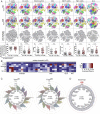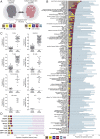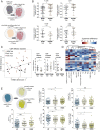Immune signatures of prodromal multiple sclerosis in monozygotic twins
- PMID: 32817525
- PMCID: PMC7474627
- DOI: 10.1073/pnas.2003339117
Immune signatures of prodromal multiple sclerosis in monozygotic twins
Abstract
The tremendous heterogeneity of the human population presents a major obstacle in understanding how autoimmune diseases like multiple sclerosis (MS) contribute to variations in human peripheral immune signatures. To minimize heterogeneity, we made use of a unique cohort of 43 monozygotic twin pairs clinically discordant for MS and searched for disease-related peripheral immune signatures in a systems biology approach covering a broad range of adaptive and innate immune populations on the protein level. Despite disease discordance, the immune signatures of MS-affected and unaffected cotwins were remarkably similar. Twinship alone contributed 56% of the immune variation, whereas MS explained 1 to 2% of the immune variance. Notably, distinct traits in CD4+ effector T cell subsets emerged when we focused on a subgroup of twins with signs of subclinical, prodromal MS in the clinically healthy cotwin. Some of these early-disease immune traits were confirmed in a second independent cohort of untreated early relapsing-remitting MS patients. Early involvement of effector T cell subsets thus points to a key role of T cells in MS disease initiation.
Keywords: autoimmunity; biomarker; immune phenotyping; monozygotic twins; multiple sclerosis.
Copyright © 2020 the Author(s). Published by PNAS.
Conflict of interest statement
The authors declare no competing interest.
Figures




Comment in
-
The immune signatures of multiple sclerosis: Lessons from twin studies.Proc Natl Acad Sci U S A. 2020 Sep 29;117(39):24013-24015. doi: 10.1073/pnas.2016711117. Epub 2020 Sep 14. Proc Natl Acad Sci U S A. 2020. PMID: 32929024 Free PMC article. No abstract available.
References
-
- Engelhardt B., Vajkoczy P., Weller R. O., The movers and shapers in immune privilege of the CNS. Nat. Immunol. 18, 123–131 (2017). - PubMed
-
- Sospedra M., Martin R., Immunology of multiple sclerosis. Semin. Neurol. 36, 115–127 (2016). - PubMed
-
- Thompson A. J., Baranzini S. E., Geurts J., Hemmer B., Ciccarelli O., Multiple sclerosis. Lancet 391, 1622–1636 (2018). - PubMed
-
- Ben-Nun A., Wekerle H., Cohen I. R., Pillars article: The rapid isolation of clonable antigen-specific T lymphocyte lines capable of mediating autoimmune encephalomyelitis. Eur J Immunol. 1981.11: 195-199. J. Immunol. 198, 3384–3388 (2017). - PubMed
-
- Zamvil S. S., Steinman L., The T lymphocyte in experimental allergic encephalomyelitis. Annu. Rev. Immunol. 8, 579–621 (1990). - PubMed
Publication types
MeSH terms
Substances
Grants and funding
LinkOut - more resources
Full Text Sources
Medical
Research Materials

